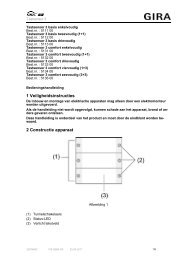Blind actuator 1-gang flush-mounted Order-No. 2165 00 - Gira
Blind actuator 1-gang flush-mounted Order-No. 2165 00 - Gira
Blind actuator 1-gang flush-mounted Order-No. 2165 00 - Gira
You also want an ePaper? Increase the reach of your titles
YUMPU automatically turns print PDFs into web optimized ePapers that Google loves.
4.2.4.3.2 Disabling function for extension inputs<br />
Software "Venetian blind, input 20BD11"<br />
Functional description<br />
The extension inputs can be separately disabled via the bus using 1-bit objects. With the<br />
"Switching" function, it is possible to disable the two switching objects of an input independently<br />
of each other.<br />
With an active disabling function, signal flanks at the input are ignored by the device related to<br />
the affected objects.<br />
Each input or each switching object can execute a specific independent reaction at the<br />
beginning or end of a disable. This reaction is specified on the parameter page<br />
"Ix - disable" (x = 1, 2, 3) in the ETS and is dependent on the flank evaluation defined for the<br />
affected input. In so doing, it is possible to configure to "<strong>No</strong> reaction". Only in this case are<br />
dimming or Venetian blind control operations or value adjustments completed during an active<br />
disable and only then the input locked. In all other cases, the configured disabling command is<br />
executed immediately at the beginning of disabling.<br />
In the "Transmit current input status" setting, the device evaluates the current static signal<br />
status of the input and, according to this, transmits the appropriately configured telegram to the<br />
bus (contact closed at the input = telegram as with rising flank; contact open at input = telegram<br />
as with falling flank).<br />
A disabling function is activated or deactivated by the corresponding 1-bit object. The telegram<br />
polarity can be set in the ETS for each disabling object. The disabling object is always inactive<br />
after a device reset. Even with an inverted polarity "Disabling = 0 (Enabling = 1)", a "0" telegram<br />
must first be received after a reset until the appropriate disabling function is activated.<br />
i Updates to disabling objects with the same telegram polarity (disabling -> disabling or<br />
enabling -> enabling) do not show a reaction.<br />
i With cyclical transmission in the "Switching" function: during an active disable, cyclical<br />
transmission does not take place via the disabled input switching object. Cyclical<br />
transmission is continued immediately at the end of the disabling with the last object value<br />
written to the object, providing that the transmit criterion for cyclical transmission is fulfilled<br />
(transmit on ON, on OFF or on ON and OFF).<br />
<strong>Order</strong>-<strong>No</strong>. <strong>2165</strong> <strong>00</strong><br />
Page 36 of 149

















